Hecla Mining Bundle
What's the Story Behind Hecla Mining Company?
Journey back in time and discover the captivating Hecla Mining SWOT Analysis of Hecla Mining Company, a true titan of the North American mining industry. From its humble beginnings in the late 1800s, this company has weathered over a century of change, constantly adapting and evolving in the face of market shifts and technological advancements. Uncover the secrets of Hecla's enduring success and its remarkable contribution to the world of silver and gold production.
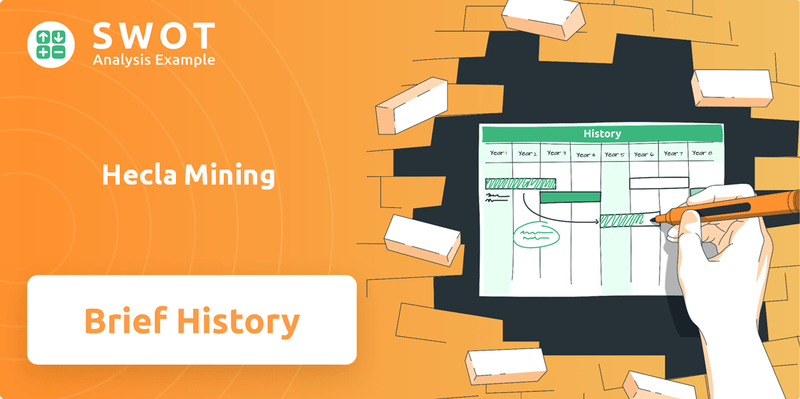
The Hecla history is a testament to the resilience of the mining industry, showcasing how a company can grow from a regional player to a leader in silver production. Founded in 1891 in Wallace, Idaho, Hecla Mining Company quickly made its mark, driven by the rich mineral deposits found in the Coeur d'Alene district. Exploring the Idaho mines and beyond, the company's story is filled with strategic decisions, innovative projects, and a lasting impact on the global precious metals market.
What is the Hecla Mining Founding Story?
The Hecla Mining Company's story began on October 14, 1891, in Wallace, Idaho. It was a direct result of the booming mining scene in the Coeur d'Alene Mining District, known for its rich silver and lead deposits. The company's formation was driven by the collective efforts of early prospectors and investors eager to capitalize on the mineral wealth of the Gem State.
The initial focus was on the Hecla Mine, a major silver-lead vein that promised significant profits. The business model was simple: extract, process, and sell silver and lead ore to smelters. Funding came from a mix of private investments and share sales to build the necessary infrastructure for mining operations.
The name 'Hecla' was derived from the Hecla Mine, which likely took its name from Mount Hekla, an active volcano in Iceland. This choice perhaps symbolized the mine's powerful and productive nature. The late 19th century, with its rapid industrialization and high demand for raw materials, set the stage for the company's creation and early success. To learn more about how the company has grown over time, check out the Growth Strategy of Hecla Mining.
Hecla Mining Company was established in 1891, during a period of significant mining activity in Idaho.
- The company's origins are tied to the Coeur d'Alene Mining District, known for its silver and lead.
- The primary goal was to extract and sell silver and lead ore.
- Early funding came from private investments and the sale of shares.
- The name 'Hecla' was inspired by the Hecla Mine, reflecting its productive potential.
Hecla Mining SWOT Analysis
- Complete SWOT Breakdown
- Fully Customizable
- Editable in Excel & Word
- Professional Formatting
- Investor-Ready Format
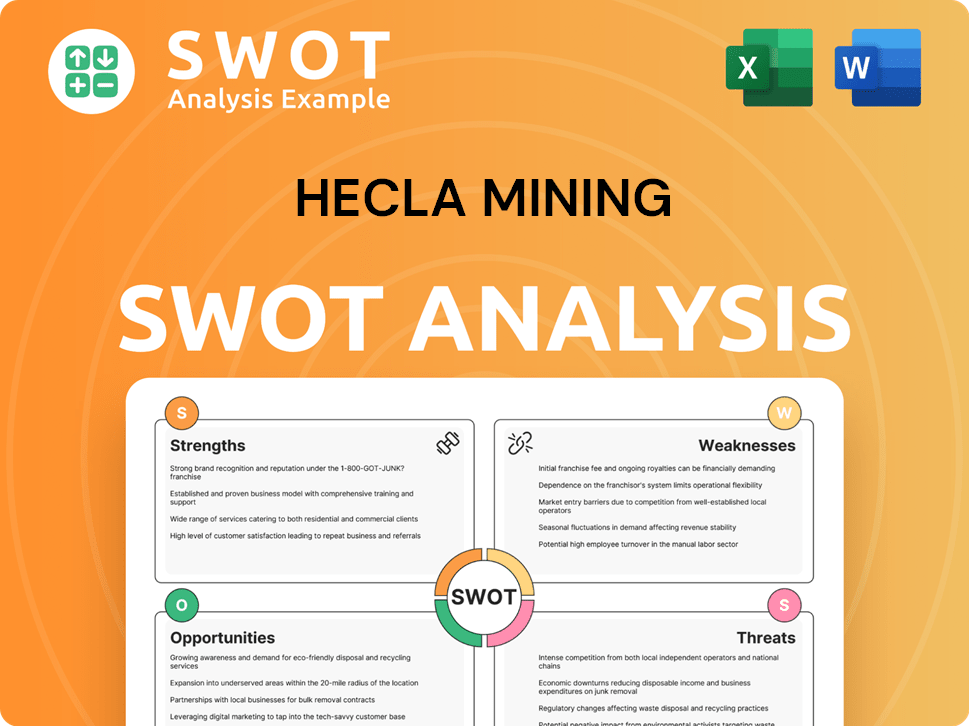
What Drove the Early Growth of Hecla Mining?
The early growth and expansion of Hecla Mining Company, a significant player in the mining industry, was significantly shaped by the success of its namesake Hecla Mine in Burke, Idaho. This mine quickly became a major producer of silver and lead, establishing the company's initial prominence. The company's early years set the stage for its future growth, focusing on efficient mineral extraction and strategic expansion within the Coeur d'Alene district.
Hecla's early success was built on the Hecla Mine, which was a key driver of Hecla history. Initial operations involved expanding underground workings and improving milling processes. Reinvesting profits into exploration and acquiring additional mineral claims was a crucial strategy. This expansion focused on the Coeur d'Alene region, a key area for silver production.
Throughout the 20th century, Hecla Mining Company expanded through acquisitions and mine development. The company diversified its portfolio to include zinc and gold, moving beyond its initial focus on silver and lead. This expansion was driven by the need to find new deposits and adapt to market changes. Navigating the mining industry's cycles was essential for continued growth.
Leadership transitions often involved experienced mining engineers who could handle technical and economic challenges. The company's ability to adapt to market fluctuations, including periods of high and low metal prices, was critical. By the latter half of the 20th century, Hecla had become a multi-mine operator with a broader geographical presence. For more detailed insights into Hecla's business model, consider reading Revenue Streams & Business Model of Hecla Mining.
Hecla's early growth significantly impacted the Coeur d'Alene district and the broader mining industry. The company's strategic acquisitions and exploration projects expanded its footprint. Hecla's historical impact continues to influence its current operations as a diversified precious metals producer. The company's legacy is built on its ability to adapt and grow over many decades.
Hecla Mining PESTLE Analysis
- Covers All 6 PESTLE Categories
- No Research Needed – Save Hours of Work
- Built by Experts, Trusted by Consultants
- Instant Download, Ready to Use
- 100% Editable, Fully Customizable
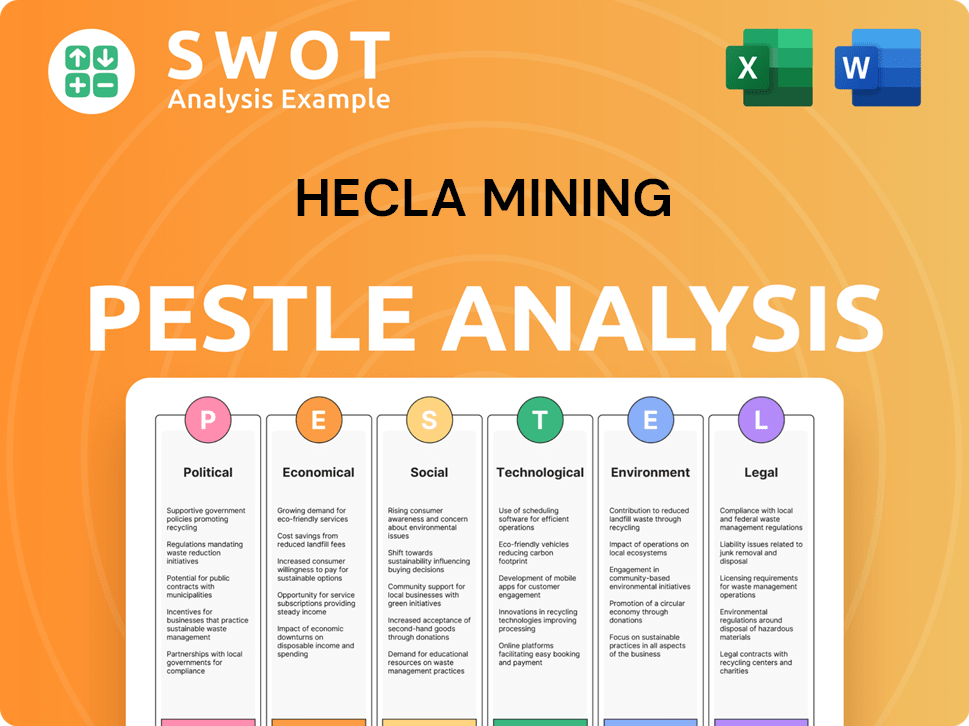
What are the key Milestones in Hecla Mining history?
The Hecla Mining Company has a rich history marked by significant milestones in the mining industry. A key achievement has been the development of the Lucky Friday Mine, which has been a cornerstone of its silver production for decades. Moreover, the company has consistently expanded its operations and resource base through strategic acquisitions and exploration projects.
| Year | Milestone |
|---|---|
| Early 1890s | Founding of the Hecla Mining Company in the Coeur d'Alene district of Idaho, marking the beginning of its silver mining operations. |
| 1930s | Hecla Mining Company navigated the challenges of the Great Depression, demonstrating resilience and adaptability in the face of economic downturn. |
| Mid-20th Century | The company expanded its operations, including the acquisition of the Lucky Friday Mine, which became a key asset for silver production. |
| 2000s | Hecla Mining Company focused on exploration, acquisitions, and strategic partnerships to grow its silver and gold reserves. |
| 2024 | Lucky Friday Mine continues to be a vital asset, benefiting from operational improvements and a new labor agreement. |
Hecla Mining Company has consistently embraced innovation in mining techniques and safety. They have adapted to evolving industry standards and technological advancements to optimize extraction and processing, improving efficiency and safety in their operations.
Hecla has implemented advanced mining methods to improve ore extraction and reduce environmental impact. This includes the use of modern drilling and blasting techniques.
The company has invested in robust safety protocols and training programs to protect its workforce. They use advanced safety technologies.
Hecla has begun to integrate automation and robotics in its mining operations for efficiency and safety. This includes remote-controlled equipment.
The company uses sophisticated geological modeling to better understand ore deposits and optimize extraction strategies. This helps in resource management.
Hecla invests in advanced processing technologies to improve the efficiency of extracting silver from ore. This includes modern flotation methods.
Hecla is committed to environmentally sustainable practices, including water management and waste reduction. They focus on minimizing their environmental footprint.
Hecla Mining Company has faced various challenges, particularly the cyclical nature of commodity prices, impacting revenues and profitability. Operational difficulties, such as geological complexities and labor disputes, have also affected production and financial performance.
Fluctuations in silver and gold prices have caused variable revenues and profitability. The company must implement cost-cutting measures during market downturns.
Mining in complex geological environments presents operational challenges. This can affect extraction rates and increase costs.
Labor disputes, such as the past strike at Lucky Friday, have disrupted production and increased costs. These issues can impact operational efficiency.
Compliance with environmental and safety regulations adds to operational costs. Changes in regulations can also create uncertainty.
Hecla reported a net loss of $28.3 million in Q1 2024, partly due to lower silver prices and reduced production. This highlights the impact of market conditions.
Maintaining production levels and managing costs in the face of these challenges requires strategic planning. The company must adapt to changing conditions.
Hecla Mining Business Model Canvas
- Complete 9-Block Business Model Canvas
- Effortlessly Communicate Your Business Strategy
- Investor-Ready BMC Format
- 100% Editable and Customizable
- Clear and Structured Layout
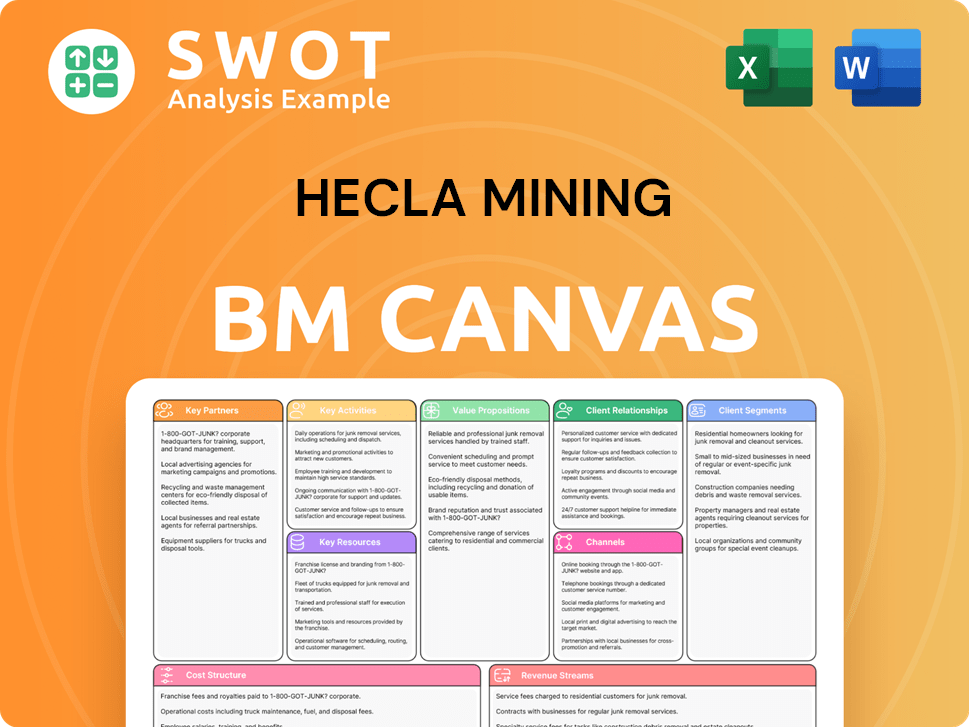
What is the Timeline of Key Events for Hecla Mining?
The Hecla Mining Company has a rich history, marked by significant milestones in the mining industry. Founded in 1891 in Wallace, Idaho, the company quickly established itself as a key player in silver production. Through strategic acquisitions and operational expansions, Hecla has navigated fluctuating metal prices and industry challenges, evolving into a leading precious metals producer. The company's journey reflects its commitment to innovation, responsible resource development, and long-term value creation.
| Year | Key Event |
|---|---|
| 1891 | Hecla Mining Company is incorporated in Wallace, Idaho, marking its official founding. |
| Early 1900s | Significant production begins at the Hecla Mine in Burke, Idaho, establishing early success. |
| 1950s | The Lucky Friday Mine in Idaho is acquired and developed, becoming a major silver producer. |
| 1970s-1980s | Hecla diversifies into other metals and regions, including gold, expanding its portfolio. |
| 1990s | The company continues expansion and strategic acquisitions, adapting to market changes. |
| 2010 | Acquisition of the Greens Creek Mine in Alaska significantly boosts silver and gold production. |
| 2012 | The Casa Berardi Mine in Quebec, Canada, is acquired, adding substantial gold production. |
| 2018 | Klondex Mines is acquired, further expanding Hecla's gold assets. |
| 2022 | Full operations resume at the Lucky Friday Mine after a labor dispute, stabilizing production. |
| 2024 | Hecla reports a Q1 net loss of $28.3 million, with a focus on operational improvements and exploration. |
| 2024 | A new five-year labor agreement at the Lucky Friday Mine is announced, ensuring stability. |
Hecla's future centers on optimizing its current operations, particularly at the Greens Creek and Lucky Friday mines. These mines are critical to its silver production, with projections aiming for up to 18.0 million ounces of silver in 2024. This focus aims to enhance efficiency and maximize output from its established assets.
The company plans to expand its resource base through strategic exploration in Alaska, Idaho, and Quebec. The goal is to discover new high-grade deposits and extend the life of its mines. Investment in exploration is a key strategy for long-term growth and sustainability.
Hecla emphasizes sustainable mining practices and responsible resource development. This approach aligns with industry trends and stakeholder expectations. The company aims to minimize its environmental impact and ensure responsible resource management.
Analyst predictions often highlight Hecla's leverage to silver prices and its established production profile. The company's leadership is committed to long-term value creation. The focus remains on disciplined capital allocation and operational excellence to build on its legacy as a premier precious metals producer.
Hecla Mining Porter's Five Forces Analysis
- Covers All 5 Competitive Forces in Detail
- Structured for Consultants, Students, and Founders
- 100% Editable in Microsoft Word & Excel
- Instant Digital Download – Use Immediately
- Compatible with Mac & PC – Fully Unlocked
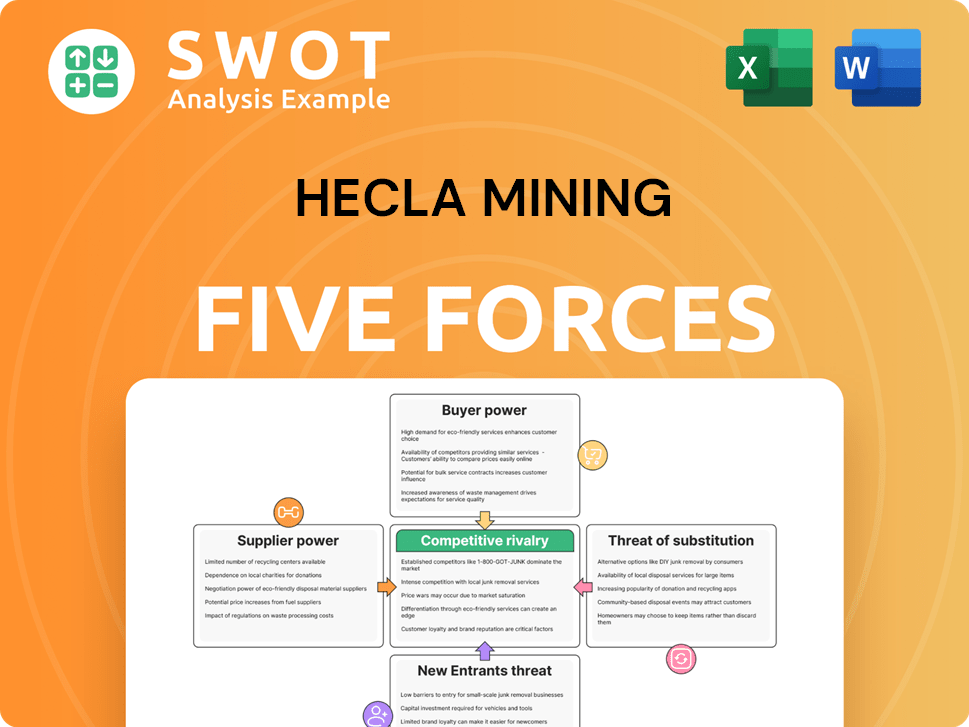
Related Blogs
- What is Competitive Landscape of Hecla Mining Company?
- What is Growth Strategy and Future Prospects of Hecla Mining Company?
- How Does Hecla Mining Company Work?
- What is Sales and Marketing Strategy of Hecla Mining Company?
- What is Brief History of Hecla Mining Company?
- Who Owns Hecla Mining Company?
- What is Customer Demographics and Target Market of Hecla Mining Company?
Disclaimer
All information, articles, and product details provided on this website are for general informational and educational purposes only. We do not claim any ownership over, nor do we intend to infringe upon, any trademarks, copyrights, logos, brand names, or other intellectual property mentioned or depicted on this site. Such intellectual property remains the property of its respective owners, and any references here are made solely for identification or informational purposes, without implying any affiliation, endorsement, or partnership.
We make no representations or warranties, express or implied, regarding the accuracy, completeness, or suitability of any content or products presented. Nothing on this website should be construed as legal, tax, investment, financial, medical, or other professional advice. In addition, no part of this site—including articles or product references—constitutes a solicitation, recommendation, endorsement, advertisement, or offer to buy or sell any securities, franchises, or other financial instruments, particularly in jurisdictions where such activity would be unlawful.
All content is of a general nature and may not address the specific circumstances of any individual or entity. It is not a substitute for professional advice or services. Any actions you take based on the information provided here are strictly at your own risk. You accept full responsibility for any decisions or outcomes arising from your use of this website and agree to release us from any liability in connection with your use of, or reliance upon, the content or products found herein.